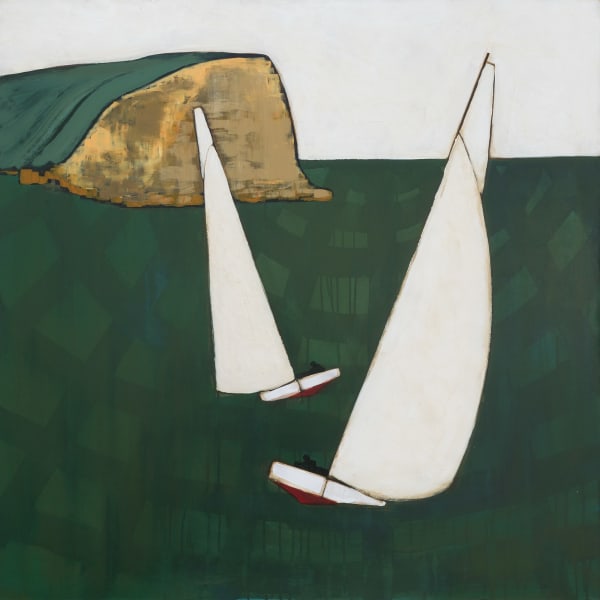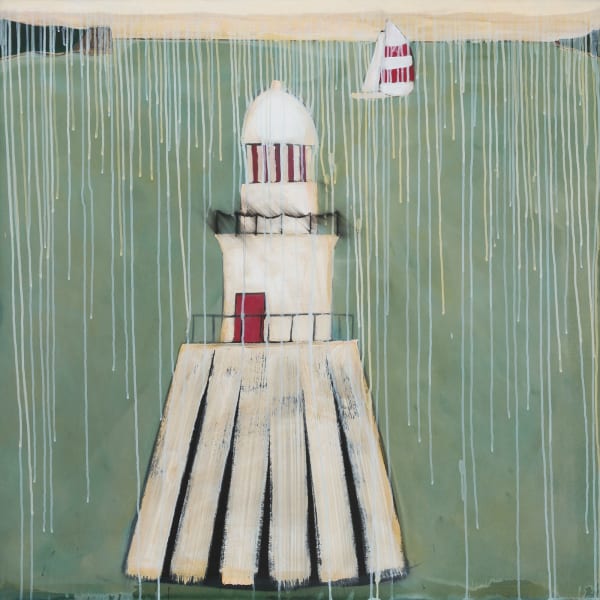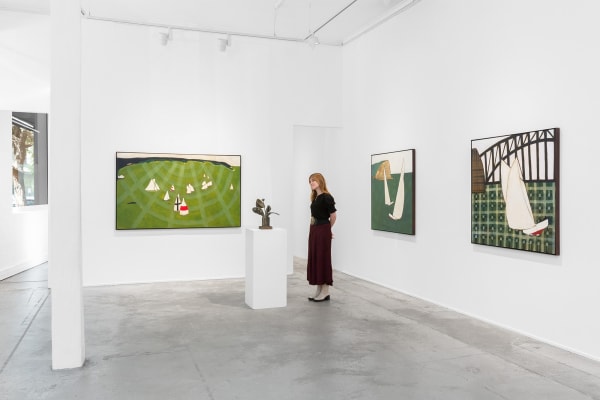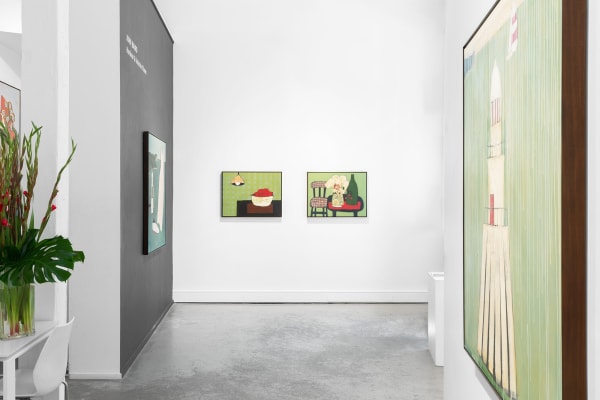John Baird: Harbour and Interior Views
-
 John BairdNorthern Shoreline, 2022acrylic & shellac on board120 x 120 cm, 123 x 123 cm (framed)Sold
John BairdNorthern Shoreline, 2022acrylic & shellac on board120 x 120 cm, 123 x 123 cm (framed)Sold -
 John BairdBottle Brush, 2022acrylic, shellac & wallpaper on board80 x 60 cm, 82 x 62 cm (framed)Sold
John BairdBottle Brush, 2022acrylic, shellac & wallpaper on board80 x 60 cm, 82 x 62 cm (framed)Sold -
 John Baird8 Metre Match II, 2022acrylic & shellac on board120 x 120 cm, 123 x 123 cm (framed)Sold
John Baird8 Metre Match II, 2022acrylic & shellac on board120 x 120 cm, 123 x 123 cm (framed)Sold -
 John BairdWilliam Morris Floral, 2022acrylic, shellac & wallpaper on board80 x 60 cm, 82 x 62 cm (framed)Sold
John BairdWilliam Morris Floral, 2022acrylic, shellac & wallpaper on board80 x 60 cm, 82 x 62 cm (framed)Sold -
 John BairdGingham Harbour, 2022acrylic & shellac on board120 x 120 cm, 123 x 123 cm (framed)Sold
John BairdGingham Harbour, 2022acrylic & shellac on board120 x 120 cm, 123 x 123 cm (framed)Sold -
 John BairdArrangement with Chairs, 2022acrylic, shellac & wallpaper on board80 x 60 cm, 82 x 62 cm (framed)Sold
John BairdArrangement with Chairs, 2022acrylic, shellac & wallpaper on board80 x 60 cm, 82 x 62 cm (framed)Sold -
 John Baird8 Metre Match I, 2022acrylic & shellac on board120 x 120 cm, 123 x 123 cm (framed)Sold
John Baird8 Metre Match I, 2022acrylic & shellac on board120 x 120 cm, 123 x 123 cm (framed)Sold -
 John BairdRed Cloth, 2022acrylic, shellac & wallpaper on board60 x 80 cm, 62 x 82 cm (framed)Sold
John BairdRed Cloth, 2022acrylic, shellac & wallpaper on board60 x 80 cm, 62 x 82 cm (framed)Sold -
 John BairdRadiant Harbour, 2022acrylic & shellac on board120 x 200 cm, 123 x 203 cm (framed)Sold
John BairdRadiant Harbour, 2022acrylic & shellac on board120 x 200 cm, 123 x 203 cm (framed)Sold -
 John BairdGreen Gingham Wall, 2022acrylic, shellac & wallpaper on board60 x 80 cm, 62 x 82 cm (framed)Sold
John BairdGreen Gingham Wall, 2022acrylic, shellac & wallpaper on board60 x 80 cm, 62 x 82 cm (framed)Sold -
 John BairdBridge and Lighthouse, 2022acrylic & shellac on board120 x 120 cm, 123 x 123 cm (framed)Sold
John BairdBridge and Lighthouse, 2022acrylic & shellac on board120 x 120 cm, 123 x 123 cm (framed)Sold -
 John BairdSydney in the Rain, 2022acrylic & shellac on board120 x 120 cm, 123 x 123 cm (framed)Sold
John BairdSydney in the Rain, 2022acrylic & shellac on board120 x 120 cm, 123 x 123 cm (framed)Sold -
 John BairdEngineered Still Life, 2022unique bronze40 x 36 x 25.5 cm
John BairdEngineered Still Life, 2022unique bronze40 x 36 x 25.5 cm -
 John BairdSmall Still Life, 2022unique bronze31 x 22.5 x 18.5 cm
John BairdSmall Still Life, 2022unique bronze31 x 22.5 x 18.5 cm
Working across painting, collage and sculpture, John Baird has developed a singular aesthetic that explores slippages between utilitarianism and decoration, memory and imagination. With a note of nostalgia, the sailboat, the dressing table and the floral arrangement are elevated from the commonplace and the viewer is invited to bask in the pleasure of pure visuality.
Baird’s new collection continues his affection for Sydney Harbour, distilling this setting into shapes and iconography. Based on the Mornington Peninsula, Baird is a visitor to the harbour, an outsider, and it is this mode of perception that allows him the freedom to indulge in fantasy and feeling, rather than realty; “I can go to the harbour and luxuriate in it, and then take what’s happened back with me to make paintings of that experience. They’re never accurate.” Baird’s favourite marine motif is the lighthouse, a lone structure ripe with symbolic potential – enlightenment, romance, rescue. In one of his paintings, the artist pictures the little lighthouse at Sow and Pigs Reef, rendered tenderly. It bobs up and down in the foreground, a vertical dance heightened by the beat of the drips.
When describing his approach, Baird explains that he doesn’t “remember” these sea scenes as such, but carries them with him always, like an old friend. Though sailboats and lighthouses are salient subjects, of greatest importance to him is the ocean itself. Consciously, Baird “gets the water wrong” in ways that spotlight its unusual beauty. Having spent time on a boat under the Sydney Harbour Bridge, the artist recalls how here the water resembles a crosshatch of lines with little intersecting peaks. He translates this abstract vision into gingham effects, playing with pattern to reveal alternate ways of seeing. A new process for Baird has been using wet paint to capture the ‘wetness’ of the water, painting for the first time on wooden panels, sitting upright instead of lying flat, to allow the diluted acrylic to drip down the surface. Baird’s use of panels in this series has also allowed him to apply more layers of shellac in between the many layers of paint. This brings the colours into the same chord, but also gives each scene a golden hue – as if glimpsed through the nostalgic membrane of memory.
This is one of the first series Baird has created in the wake of a serious illness three years ago. After major surgery, the artist experienced synaesthesia, where he began hearing colour. In the works that followed, Baird would “find the sound of colour”, both consciously and subconsciously. The palette of his latest works is informed by this synaesthesic tool, which Baird “switches on” to find harmony and beauty. “The greens are a particularly beautiful sound. The greens I’ve used for the sea have an oboe quality to them”, he explains.
This collection also features a set of still lifes, more investigative than earlier works as the artist plays with processes of creation and destruction. An original drawing is made, and the forms are pushed and pulled with paint across many layers of colour until the composition reaches a point where Baird is satisfied. Then, he covers it with a dark varnish and starts over – a cathartic act symptomising his drive to “constantly look for more”. Created entirely from imagination, Baird’s still lifes are whimsical extensions of his mind; dream-like scenes without spatial or temporal context – where the eye is free to roam on a purely visual level.
There is something decidedly joyful about John Baird’s paintings. Following his illness and recovery, Baird reflects that his paintings have become more optimistic than those of his “previous life”. Describing the sounds of certain colours, the artist remarks “the centre of the sky on a bright sunny day is a middle C – the frequency that we all most relate to.” His works indeed strike a middle C in the viewer’s mind. The simplicity of form, purity of palette and genuineness of subject make them as relatable as they are beautiful.
Elli Walsh, Art Writer






















